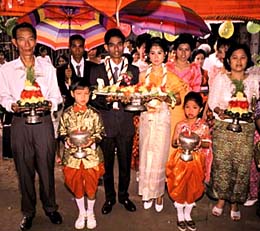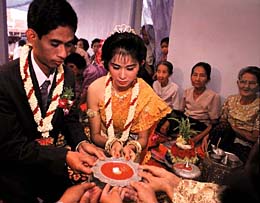The Urge to Merge
When the Mekong River reverses its flow, residents of war-torn Cambodia celebrate the miracle of the life-sustaining waters with a frenzy of fireworks and quick-dash courtship
By Ron Gluckman/Phnom Penh, Cambodia
I
N MOST PARTS OF THE WORLD, when the weather grows miserably muggy, the thoughts of young men turn to air conditioning and cold beers. In this war-ripped republic, the soggy season puts guys in a romantic mood. In Cambodia, monsoons mean matrimony.The prelude to this concupiscent outpouring was the madness reigning up and down the banks of the Mekong River earlier this month, as Cambodia’s annual Retreat of the Waters Festival celebrates the miracle of the Mekong, which spends half the year pouring into the Tonle Sap, making the puddle on the outskirts of the Cambodian capital the largest lake in Southeast Asia. When the monsoons end, the river reverses its flow, and the natural reservoir sends water back into the rice fields that feed the entire region.
To celebrate this amazing natural phenomena, there were hails of gunfire and fireworks, and gunboats that may have seen action in "Apocalypse Now," done up like floats, Christmas lights draped around the canons. And, in this crazed atmosphere, courtships quickly blossomed and there was romance and marriage on the Mekong.
 Matrimony suffered along with everything else in Cambodia through
decades of civil war and genocide. But nowadays, every season at this time, three things
happen like clockwork: the weather gets incredibly hot and sticky, the Mekong River
reverses its flow, and young men and women get hitched in droves.
Matrimony suffered along with everything else in Cambodia through
decades of civil war and genocide. But nowadays, every season at this time, three things
happen like clockwork: the weather gets incredibly hot and sticky, the Mekong River
reverses its flow, and young men and women get hitched in droves.
Cupid comes to the Killing Fields every winter, after the monsoons. As many as 80 percent of all Cambodian weddings occur during the first two months of dry season.
But the mating frenzy begins long before the last raindrops fall. Match makers, known as Che Chau (the go betweens) circulate through Cambodian cities and towns during the summer, sizing up prospective suitors. By September, the eligible bachelors and blushing bride wanna-bes are in a tizzy.
"Do you have prospects?’ Everyone is asking that right now," said my 21-year-old cyclo driver in Phnom Penh. "All my friends want to be married right away, if they can only find someone. That’s the hard part."
Frantically searching for prospective partners is the main activity of young Cambodians at the festival, which has grown bigger every year since the government reinstated the celebration somewhat modestly in 1991, following decades of Khmer Rouge and communist suppression. But those bleak days are hardly remembered. Nowadays, carnival booths line the river banks, and rock bands play on stages in front of monster beer tents. Dragonboat races fill the days and drinking fills the nights. The entire city is in a frenzy for days.
Afterwards, wedding bells toll for many. In olden times, Cambodian weddings lasted for three days or more. Traditionally, the wedding would begin with the Choun Pelea, a ceremony that publicly set the time and date for the union. But, before that, the groom often had to spend years building a home for his bride’s family.
Nowadays, the wedding ceremony has been trimmed to a single, but it starts early, just after dawn. Guests gather at the groom’s family home, where huge silver platters are piled high with treats. There are apples, bananas, grapes and sweets, plus loads of presents and precious cooked pig’s legs.
The wedding party parades this bounty through the streets. Minstrels lead the procession, with the groom’s family and best friends close behind. Banging pots and chanting, this noisy group sidesteps sleeping dogs and cyclo drivers, while serenading the backstreet population of Phnom Penh. Smiling people watch from balconies. Some send down a shower of flower petals.
 At one recent wedding, the bride first appeared as a princess
dressed in gold, hair tucked into a sparkling tiara. She was helped by a clutter of
girlfriends, all giggling while making last-minute adjustments before a large mirror. The
groom began in western dress, changed to a casual sarong, then a royal robe for the final
ceremony. Along the way, his feet were washed and perfumed, and his hair ceremonially
clipped. In turn, the groom made offerings to a man dressed in white, the priest or achar,
and to the spirits of his ancestors.
At one recent wedding, the bride first appeared as a princess
dressed in gold, hair tucked into a sparkling tiara. She was helped by a clutter of
girlfriends, all giggling while making last-minute adjustments before a large mirror. The
groom began in western dress, changed to a casual sarong, then a royal robe for the final
ceremony. Along the way, his feet were washed and perfumed, and his hair ceremonially
clipped. In turn, the groom made offerings to a man dressed in white, the priest or achar,
and to the spirits of his ancestors.
Finally, after much music and chanting, the achar grabbed a sword and touched it to the groom’s shoulder, than to his bride. A musician sang a final song, the "Withdrawing of the Curtains." The priest proclaimed the completion of the Pelea Ruom Khnoevy, literally "the uniting of the pillows."
Food was served, presents accepted, and songs continued into the night. Outside, the sounds of the festival mingled with sporadic gunfire, while rock music continued until nearly dawn at Phnom Penh’s waterfront. As the morning broke, packs of drowsy youths picked their way among the rubbish around the carnival booths. The cyclo drivers continued their search, both for passengers and partners. But one more marriage had been consummated.
After months of monsoons, in a country consumed by war and corruption, the nuptials represent more than a nod to the traditions of the past. Each marriage here in Cambodia is a moral victory, and another hope for the future.
Ron Gluckman is an American reporter who wanders around the Asian region for a number of publications, including the Wall Street Journal, which ran this piece in November 1993. Similar stories by Mr Gluckman also appeared in Silk Roads and the South China Morning Post.
The photos on this page, and much of the early scanning for this web site, are the work of David Paul Morris, an American photographer who often travels with Ron Gluckman.
To return to the opening page and index

push here
[right.htm]